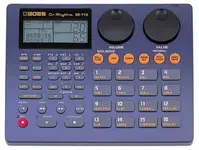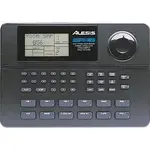Alesis SR-16 Drum Machine
I finally got a drum machine (Jan, 2000). I bought a used Alesis SR-16 from a friend for $125.00. This machine is a bit out of date (it has been in producton for 10 years now) but is probably still a good deal for the money. The list price is $350.00. You can find them new for $210.00 - 260.00. They sell on eBay for $125 - $200. The SR-16 replaced the HR-16 and HR-16B, which were made for just a couple of years before the SR-16 came out.
Drum machines can be useful as a practice tool for drummers, guitarists, or any musicians. They can be used as just a metronome, so there's no need to buy a metronome if you have a drum machine. If you are a drummer, it can be useful to mess with a drum machine just to learn more about the science of making beats. And they are just fun to play with.
The SR-16 can plug into a regular guitar amp or into just about anything. A power adapter is needed. The SR-16 does not use batteries. If you buy a used one, make sure the adapter is included, otherwise you will need to buy one. I think you can order them from Alesis and maybe you can just get one at Radio Shack. If you get a used SR-16 and it doesn't have a manual, you can download one from Alesis (see below).
If you do get a used SR-16, you will probably want to clear out the memory right away.
There is a battery inside the unit which is used to retain settings and beats that you program into it. This battery should probably last about ten years or so. If your SR-16 will not remember things anymore, it may need a new battery. Alesis can replace it for you, but this may cost $50.00 or so plus the cost and trouble of shipping. Anyone who can use a soldering iron can replace the battery. To disassemble the SR-16, remove the six screws on the bottom. There is a ribbon cable that connects the top and bottom together. This should be unplugged from the bottom part (main circuit board). The pins on the connector are very fragile, so pry it up carefully with a screwdriver. Also the volume knob has to come off. To remove the circuit board, just unscrew the nuts on the six phone jacks on the back. The battery is a coin-shaped 3-volt lithium battery. The one in mine is a Panasonic BR2325. If you buy a replacment battery, you will need to get one that has PCB terminals on it so it can be soldered. I THINK this is Panasonic part number BR2325-1HB (theres lots of different types of connectors on these). You will not find this at Walmart. It will need to be ordered from an electronics supply place. Digikey has them for $2.00. I think you can get one from Alesis for 15 or 20 dollars.
You will also see a bunch of chips in sockets, including one with a paper label on top. This is a 512Kb EPROM chip (27C512) containing the the software. The version is indicated on the label.
The manual is good but it doesn't cover some subjects very thoroughly. One thing that can mess you up is the Swing feature. If you record a voice with Swing enabled, then turn off Swing, and then go back and erase that voice, it may not erase the notes. You will need to go back set Swing to wherever it was when you recorded that voice.
One way to learn how to do some things is to go and look at how the preset beats were made.


